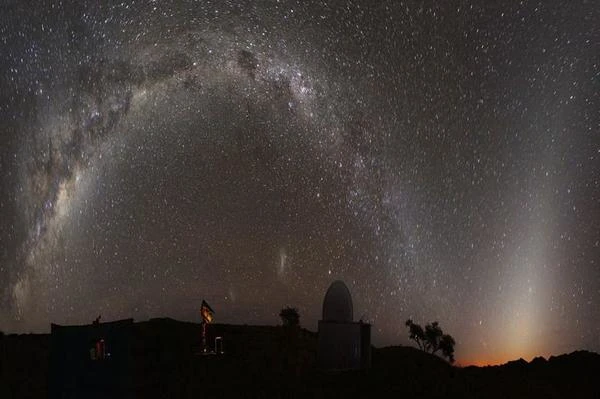
Sunlight scatters off a cloud of fine dust, called interplanetary dust, mainly located in the plane of the ecliptic. These particles typically range in size from 10 to 100 µm and are mostly composed of silicates and amorphous carbon, which influences their reflection coefficient and the scattered light spectrum.
The luminous phenomenon manifests as a diffuse glow visible just before sunrise or after sunset, forming a cone or band along the ecliptic. The intensity and visibility of zodiacal light depend on several physical and geometric factors, including the angle between the Sun, Earth, and the dust cloud, as well as the local concentration of particles.
Seasonal variations are also observable: zodiacal light is more easily detected during autumn and spring in the northern hemisphere, when the inclination of the ecliptic allows the Sun to project light through a greater thickness of the dust cloud. Observations from high-altitude sites with very little light pollution provide better conditions for distinguishing this phenomenon, which is also an indirect indicator of the distribution and origin of interplanetary dust in the Solar System.
The intensity of zodiacal light depends on the local density of dust, the angle of illumination by the Sun, and atmospheric absorption. Observations from high-altitude and low-pollution sites offer the best conditions. It is more visible during the twilights of autumn and spring in the northern hemisphere.
The study of zodiacal light helps characterize the population of dust in the Solar System and identify their cometary or asteroidal origins. It also poses a challenge for deep astronomical observations due to the parasitic light it generates.
| Property | Typical value | Unit | Comment |
|---|---|---|---|
| Average radius | 10-100 | µm | Particles large enough to scatter visible light via the Mie effect |
| Volume density | 10⁻¹⁹ to 10⁻¹⁸ | kg/m³ | Very low density, explaining the diffuse appearance and low brightness |
| Composition | Silicates, carbon | - | Influences reflectivity and the scattered light spectrum |
| Light scattering | Dominantly Mie | - | Particles comparable in size to visible wavelengths scatter light anisotropically |
Scientific sources and literature analysis on interplanetary dust.